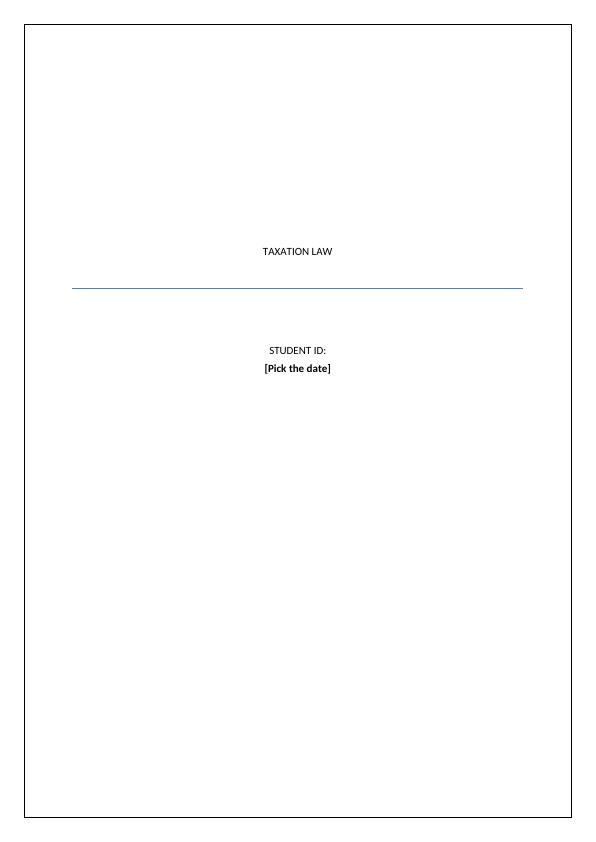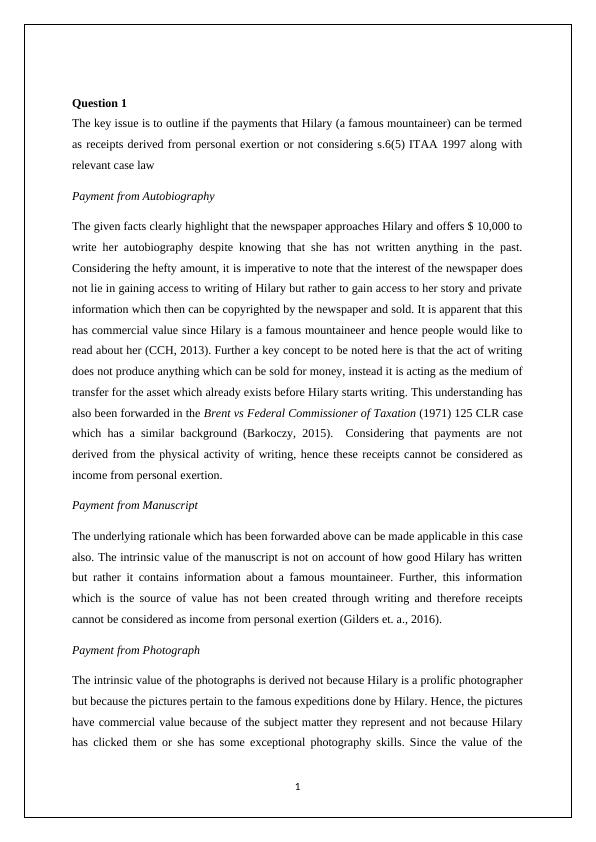Taxation Law: Payments from personal exertion, car fringe benefit, financial assistance, and CGT computation
Added on 2023-06-11
7 Pages1916 Words196 Views
TAXATION LAW
STUDENT ID:
[Pick the date]
STUDENT ID:
[Pick the date]

Question 1
The key issue is to outline if the payments that Hilary (a famous mountaineer) can be termed
as receipts derived from personal exertion or not considering s.6(5) ITAA 1997 along with
relevant case law
Payment from Autobiography
The given facts clearly highlight that the newspaper approaches Hilary and offers $ 10,000 to
write her autobiography despite knowing that she has not written anything in the past.
Considering the hefty amount, it is imperative to note that the interest of the newspaper does
not lie in gaining access to writing of Hilary but rather to gain access to her story and private
information which then can be copyrighted by the newspaper and sold. It is apparent that this
has commercial value since Hilary is a famous mountaineer and hence people would like to
read about her (CCH, 2013). Further a key concept to be noted here is that the act of writing
does not produce anything which can be sold for money, instead it is acting as the medium of
transfer for the asset which already exists before Hilary starts writing. This understanding has
also been forwarded in the Brent vs Federal Commissioner of Taxation (1971) 125 CLR case
which has a similar background (Barkoczy, 2015). Considering that payments are not
derived from the physical activity of writing, hence these receipts cannot be considered as
income from personal exertion.
Payment from Manuscript
The underlying rationale which has been forwarded above can be made applicable in this case
also. The intrinsic value of the manuscript is not on account of how good Hilary has written
but rather it contains information about a famous mountaineer. Further, this information
which is the source of value has not been created through writing and therefore receipts
cannot be considered as income from personal exertion (Gilders et. a., 2016).
Payment from Photograph
The intrinsic value of the photographs is derived not because Hilary is a prolific photographer
but because the pictures pertain to the famous expeditions done by Hilary. Hence, the pictures
have commercial value because of the subject matter they represent and not because Hilary
has clicked them or she has some exceptional photography skills. Since the value of the
1
The key issue is to outline if the payments that Hilary (a famous mountaineer) can be termed
as receipts derived from personal exertion or not considering s.6(5) ITAA 1997 along with
relevant case law
Payment from Autobiography
The given facts clearly highlight that the newspaper approaches Hilary and offers $ 10,000 to
write her autobiography despite knowing that she has not written anything in the past.
Considering the hefty amount, it is imperative to note that the interest of the newspaper does
not lie in gaining access to writing of Hilary but rather to gain access to her story and private
information which then can be copyrighted by the newspaper and sold. It is apparent that this
has commercial value since Hilary is a famous mountaineer and hence people would like to
read about her (CCH, 2013). Further a key concept to be noted here is that the act of writing
does not produce anything which can be sold for money, instead it is acting as the medium of
transfer for the asset which already exists before Hilary starts writing. This understanding has
also been forwarded in the Brent vs Federal Commissioner of Taxation (1971) 125 CLR case
which has a similar background (Barkoczy, 2015). Considering that payments are not
derived from the physical activity of writing, hence these receipts cannot be considered as
income from personal exertion.
Payment from Manuscript
The underlying rationale which has been forwarded above can be made applicable in this case
also. The intrinsic value of the manuscript is not on account of how good Hilary has written
but rather it contains information about a famous mountaineer. Further, this information
which is the source of value has not been created through writing and therefore receipts
cannot be considered as income from personal exertion (Gilders et. a., 2016).
Payment from Photograph
The intrinsic value of the photographs is derived not because Hilary is a prolific photographer
but because the pictures pertain to the famous expeditions done by Hilary. Hence, the pictures
have commercial value because of the subject matter they represent and not because Hilary
has clicked them or she has some exceptional photography skills. Since the value of the
1

photos is based on the subject matter, hence receipts cannot be considered as income from
personal exertion (Sadiq et. al., 2016).
Intention Change
Intention change is a useful parameter only when the underlying act tends to produce
commercial value and hence leads to assessable income production. In the given case,
however, it is evident based on the discussion carried out above that the act of writing does
not have commercial worth since it is not responsible for any proceeds which are derived. It
is only acting as a means. Thus, the underlying intention would not change the conclusion
that receipts are considered as income from personal exertion (Deustch et. al., 2016).
Question 2
The objective is to ascertain the taxable value related to the car fringe benefit in accordance
with the s.9 of Fringe Benefit Tax Assessment Act, 1986. As per this section, the relevant
formula is illustrated below (Woellner, 2014).
The key inputs for the formula stated above are highlighted as follows (Sadiq et. al., 2016).
A – The cost of the car would be used to represent the base value considering that the
purchase has been enacted by the employer last year only. Hence, as per s.9, car base
value would be $50,000.
B – This does not change with the distance travelled and hence is pegged at 20%.
C – The question states this as 183 and hence the same is assumed
D – Considering the respective year under assessment, the number of days would be
365.
E – Any expenses which during the assessment year if borne by the employee are
reimbursed and hence deducted as highlighted in s.9.However, for the employee to
2
personal exertion (Sadiq et. al., 2016).
Intention Change
Intention change is a useful parameter only when the underlying act tends to produce
commercial value and hence leads to assessable income production. In the given case,
however, it is evident based on the discussion carried out above that the act of writing does
not have commercial worth since it is not responsible for any proceeds which are derived. It
is only acting as a means. Thus, the underlying intention would not change the conclusion
that receipts are considered as income from personal exertion (Deustch et. al., 2016).
Question 2
The objective is to ascertain the taxable value related to the car fringe benefit in accordance
with the s.9 of Fringe Benefit Tax Assessment Act, 1986. As per this section, the relevant
formula is illustrated below (Woellner, 2014).
The key inputs for the formula stated above are highlighted as follows (Sadiq et. al., 2016).
A – The cost of the car would be used to represent the base value considering that the
purchase has been enacted by the employer last year only. Hence, as per s.9, car base
value would be $50,000.
B – This does not change with the distance travelled and hence is pegged at 20%.
C – The question states this as 183 and hence the same is assumed
D – Considering the respective year under assessment, the number of days would be
365.
E – Any expenses which during the assessment year if borne by the employee are
reimbursed and hence deducted as highlighted in s.9.However, for the employee to
2

End of preview
Want to access all the pages? Upload your documents or become a member.
Related Documents
Taxation Law ITAA 1997 - Doclg...
|6
|1596
|50
Taxation Law - Study Material with Solved Assignments, Essays, Dissertationlg...
|6
|1330
|437
Taxation Law: Personal Exertion Income, Car Fringe Benefit, Capital Gains Tax, and Gift Taxlg...
|7
|1900
|277
Taxation Law: Analysis of Payments, Car Fringe Benefit, Capital Gains Computationlg...
|6
|1254
|306
Assignment - Taxation Law (Solution)lg...
|7
|1892
|87
Taxation Law Issues: Assignmentlg...
|8
|1915
|44
